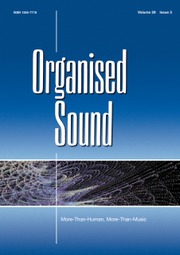No CrossRef data available.
Article contents
The Emergence of Spaces: Openness and identity/ies
Published online by Cambridge University Press: 06 October 2025
Abstract
While the relationship between space and openness has been explored in electroacoustic music since the 1960s, and contemporary composers have shown increasing interest in contingency, recent advancements in ambisonics, sound diffusion, and VR have granted composers greater control over the spatial image presented to the listener. This article revisits the discussion of space and openness through the lens of the author’s artistic practice and compositional experience, framed by new materialism, object-oriented philosophy and relational space theory. Through case studies from the author’s work, it examines spatialisation strategies that emphasise openness and the agency of sound materials. These strategies include sound source localisation, networks of family resemblances and parametric spatialisation, aiming to create an open sound experience that maintains identity while allowing agency for the sound material, the listener and the composer. In light of current global crises, partly driven by total control and exploitation, this article advocates for rethinking compositional practices to foster open sound experiences that reflect dynamic interactions between composer, material and listener.
Information
- Type
- Article
- Information
- Copyright
- © The Author(s), 2025. Published by Cambridge University Press


